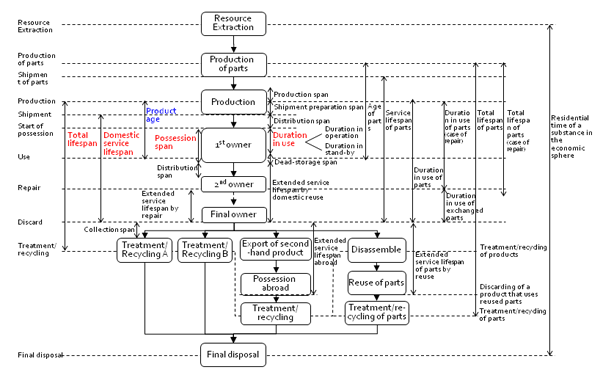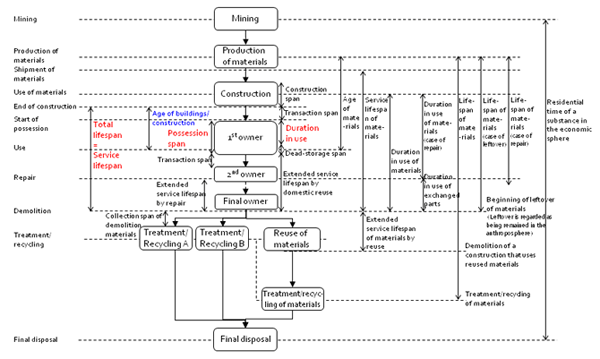Lifespan definition
For detail of Lifespan distribution type, click here.
For detail of Estimation method, click here.
Various lifespan and lifespan-related periods of commodities can be determined according to the starting and ending points of the periods. The authors determined the terminology of various periods. The figures below show the life cycles of commodities with the various terms used to describe their life. Users of lifespan data should select appropriate data for their purpose.
The important terminologies in using the database LiVES are as follows. For more details, see the literature listed in Research Results section of the top page.
Total lifespan
Total lifespan denotes the duration of the period that the goods exist in our society in their original form, regardless of whether the goods still function. Also, total lifespan only within a certain country can be defined for consumer durables and other machineries. This is defined as “domestic total lifespan.”
Service lifespan
Service lifespan denotes the duration of the period that the commodities function and can be put to use, including the duration of distribution for the next use. This is defined for commodities or parts of commodities, not for owners. Service lifespan differs from total lifespan in that this excludes collection span of discarded commodities. For buildings and construction, service lifespan equals to total lifespan in most cases as known from the figure.
Service lifespan only for a certain country can be defined. This is defined as “domestic service lifespan.” For buildings and construction, domestic service lifespan equals to service lifespan in most cases because buildings and construction are seldom exported to other countries for the purpose of reuse.
Possession span
Possession span denotes how long one owner possesses the commodity in question.
Duration in use
Duration in use denotes how long one owner uses the commodity in question. This is defined for an owner, not a commodity, and therefore this is different from service lifespan. Duration in use differs from possession span in that this excludes dead-storage span: the duration of hibernation.
Product age (Age of building/construction)
Product age or age of building/construction denotes the time span from the beginning of life of product or building/construction (the point of production or end of construction) to the time of interest.
Figure. The definition of various lifespan terminologies for consumer durables and other machineries
(If you click the above image, and it opens in another window.)

Figure. The definition of various lifespan terminologies for buildings and constructions
(If you click the above image, and it opens in another window.)
